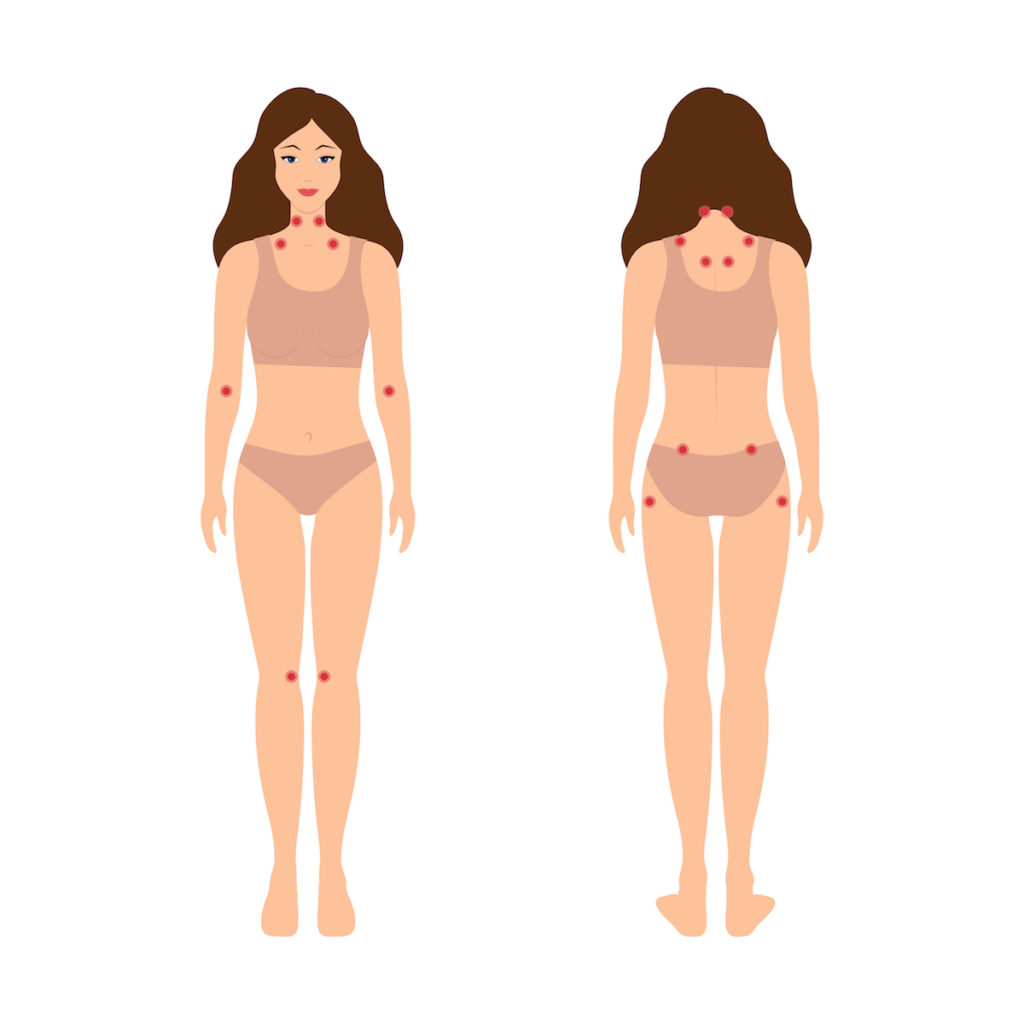Updated on 24. January 2022 from ÁYIO-Q Redaktion
Reading time: approx. 15 minutes
All important information about fibromyalgia syndrome
You or a loved one have been experiencing persistent discomfort in many parts of your body, sleep problems and feel exhausted for months? It is possible that no cause has been found yet. Maybe your doctor has thought of fibromyalgia as a result and you now want to know more about it. Here you will find all the important information about fibromyalgia.
- Overview
- Signs & Symptoms
- Causes
- Medical diagnosis
- Conventional medical treatment
- Risk factors
- 16 Natural and home remedies at a glance
What is fibromyalgia?
Fibromyalgia syndrome (FMS for short) is a permanent disorder. Fibromyalgia actually means “fibre-muscle pain”. Since various problems interact here, it is called a syndrome.
About 2 in 100 people are affected by FMS, women more often than men. The signs and symptoms generally appear between the ages of 40 and 60, much less frequently in children, adolescents or in old age. To date, the cause has not been clarified. It is suspected that personal predisposition, stressful life events, poorly processed stress and anxiety as well as overwork play a role.
Although the symptoms are often extremely painful and distressing, FMS does not cause damage to muscle mass, joints or organs. Life expectancy is normal.
What are the signs and symptoms of fibromyalgia?

People with fibromyalgia suffer from chronic discomfort and also muscle tension throughout the body. Emotional discomfort is also common. The pain is typically concentrated in certain parts of the body and has persisted for at least 3 months. The neck, back, arms, legs and chest are often affected. Sufferers are often very sensitive to stimuli such as smells, coolness, noise and bright light. Fibromyalgia patients have an increased sensitivity to pain. A distinction is made between central signs and symptoms such as chronic muscle and arm or leg pain, fatigue, difficulty falling asleep and staying asleep, and feelings of swelling, as well as other, additional signs. People who have these additional signs and symptoms have an extreme form of fybromyalgia. The severity of the signs is not the same every day. Pain-free periods are also possible.
Physical fibromyalgia signs and symptoms are:
- Joint as well as muscle tissue disorders
- Unpleasant pressure points (so-called tender points)
- Discomfort in the tapes
- Stiffness
- Burning sensation
- Frustrations
- Migraine headache
- Gastrointestinal problems, typically associated with abdominal discomfort, irregularity or diarrhoea.
- Irritable bladder (constant urge to urinate)
- Sleep disorders (problems falling asleep or sleeping through the night)
- Exhaustion and fatigue
- Focusing problems
- Swelling in the hands and feet, sometimes also in the face
- Sensitive mucous membranes
- Restless legs syndrome
- Increased reaction to pain stimuli (hyperalgesia)
- Reduced pain threshold: stimuli that are not considered painful by others are perceived as unpleasant (Allodynia)
Psychological fibromyalgia symptoms are:
- Depressions
- Inner discomfort
- Sluggishness
- Anxiety
What are the causes of fibromyalgia syndrome?
The specific causes are not known yet. However, it is known that certain factors increase the risk of developing the disease. These include stress and anxiety at work and in everyday life, various other psychological stresses such as abuse in youth or adulthood, insufficient physical activity, cigarette smoking or being overweight. Fibromyalgia syndrome can also occur as a result of an additional disease (supplementary disease), e.g. rheumatoid joint inflammation.
Research studies are currently investigating whether biochemical or neurological conditions contribute to the development of the disease.
The following causes are also considered possible triggers:
- Depressive disorders
- Vitamin D deficiency
How does the doctor diagnose fibromyalgia?

Before the diagnosis of fibromyalgia is made, a lot of time usually passes. Those affected have spent several hours in the waiting area. Generally, they are not taken seriously because the cause of their complaints cannot be determined. To be able to make a medical diagnosis, the doctor must thoroughly ask about the person’s medical history. And he must also examine the body completely. One important consideration is painful pressure factors at the attachments of the ligaments. Fibromyalgia disease cannot be diagnosed by laboratory tests. However, the doctor can rule out various other diseases by doing a blood analysis.
Which conventional medical treatment is available for fibromyalgia?
The basic clinical treatment of fibromyalgia is mostly very inadequate. Only symptomatic means are used, i.e. medication (often several at the same time), antidepressants (which are considered the front-runners, but only help one in three patients) and in the USA additionally pregabalin (Lyrica brand).
The latter is in fact a drug for severe neuropathic symptoms (polyneuropathy), anxiety as well as stress and anxiety disorders and epileptic seizures. For it to help with all these complaints, it needs to have a solid sedative (relaxing) effect – and that is exactly what this drug does.
Therefore, the undesirable side effects are not particularly surprising. Among the most typical are: Drowsiness, fatigue, drowsiness to the point of intoxication, visual disturbances (blurred or double vision), oedema, impotence, nausea and even vomiting, weight gain as well as a strong feeling of dependence, so that extreme withdrawal symptoms can occur when stopping.
Recently, however, a multimodal therapy has been recommended, which provides that the doctor offers his fibromyalgia patient – if necessary in addition to the medication – at least the following:
- 1 physically enhancing technique (endurance training, walking, dancing or cycling, as well as reflexive movement therapies such as Tai Chi or yoga exercises – 2 to 3 times a week for half an hour each),
- and additionally 1 psychotherapeutic procedure.
Are there risk factors associated with fibromyalgia?
Fibromyalgia disorders can be the result of:
- Stress and additional anxiety
- Injuries
- an illness, e.g. influenza
An imbalance in the brain’s chemical composition can cause both the brain and nerves to misunderstand or panic at common discomfort signals.
Several other elements that increase the risk of developing fibromyalgia are:
The gender – Several cases of fibromyalgia currently occur in women, although the reason for this gender difference is unclear.
The age – The likelihood of getting fibromyalgia is greatest in midlife, and the risk increases with age. But young people can also get fibromyalgia.
Family history – If you have a relative who has fibromyalgia, you are at a higher risk of developing it.
A disease – Although fibromyalgia is not a type of arthritis, having lupus or RA can increase the risk of also having fibromyalgia.
16 Natural and home remedies for fibromyalgia
We present 16 natural solutions that can relieve the symptoms of fibromyalgia.
1. Sleep
Getting enough sleep is crucial for managing fibromyalgia symptoms. Getting enough sleep helps to combat the exhaustion that comes with the disease.
Practices that can help patients achieve high quality sleep include:
- Minimising naps to a minimum
- Going to bed and getting up at the same time every day
- Restricting light and noise before bedtime
- Avoiding screen time just before bedtime
- Allow 2 to 3 hours between a full meal and bedtime.
- Avoiding alcohol and coffee before going to bed
A study from 2017 discovered a clear link between fibromyalgia symptoms and poor sleep quality. The researchers called for the development of rest methods to help people with fibromyalgia.
2. Movement
Some people with fibromyalgia may find it difficult to exercise at first, but gradual accumulation as well as endurance can bring benefits. As muscle mass becomes stronger over time, pain and discomfort must also decrease.
People with fibromyalgia need to talk to a doctor before starting an exercise programme. A physiotherapist can help set up a suitable programme.
A Cochrane study concluded that normal cardiovascular exercise, such as swimming, walking or cycling, can improve the quality of life of people with fibromyalgia. It can also lead to much better physical function and a reduction in suffering, fatigue and stiffness.
A neurological study found that a 15-week exercise programme partially reversed an unusual type of brain activity that occurs in fibromyalgia patients when the mind is at rest.
Those affected also reported a decrease in the severity of their symptoms, although there does not seem to be a link between these two elements.
3. Rest periods
People with fibromyalgia can get tired much more easily than people without the problem, and it is necessary to rest when needed. Trying to exercise or do too much can increase the pain and fatigue, so moderation is important.
If you push yourself too hard when you actually feel fit, it can lead to even more days when you feel really weak.
4. Nutrition and food supplements
A balanced and healthy diet, exercise and minimising caffeine, alcohol, nicotine and drugs can help reduce anxiety and improve mental state.
According to the National Center for Corresponding and Integrative Wellness (NCCIH), researchers have studied the performance of dietary supplements in relieving fibromyalgia symptoms.
These supplements include:
Some people also recommend topical products that contain capsaicin, the substance in chili peppers that makes them hot. However, the effectiveness of these remedies has yet to be confirmed.
Before taking supplements, it is necessary to talk to a doctor, because in some cases they can be associated with other medications or have undesirable negative effects.
5. Alkaline diet plan
To eliminate discomfort, an alkaline diet is recommended. It deacidifies and purifies the tissues. You need to drink at least 2 liters of water per day, avoid meat and eat fish more often. It is also important to eat a lot of vegetables – but to reduce the consumption of fruit.
Tip! Drink freshly squeezed vegetable juices. One to two glasses of these daily help with deacidification.
6. Alkaline baths
Foot baths (with alkaline powder or sodium bicarbonate) also support the cleansing result.
This is exactly how you apply it: Take a foot bath with it for 20 minutes every evening for fourteen days.
7. Reduce stress and anxiety
Many people report that tension makes their signs and symptoms worse. Studies have found a link between psychological anxiety and fibromyalgia.
Tips for dealing with stress and anxiety include:
- Yoga and various other types of exercise
- Diary writing or other hobbies
- Communicate as much as possible with family and friends
- Registration in a support group for fibromyalgia patients
The CDC states that minimizing stress through yoga exercise, massage therapy and meditation can help people with fibromyalgia.
They also suggest that cognitive behavioral therapy (CBT) can help sufferers change the way they think about their symptoms and stressors, which can help them manage their signs and symptoms.
8. Acupuncture

Acupuncture is a form of traditional Chinese medicine in which doctors insert small needles directly into specific triggers on the body.
Some people believe that these needles change the blood circulation and also the chemical composition of the body, which can help relieve the symptoms of fibromyalgia.
A review of research studies found that acupuncture offers some benefits for people with fibromyalgia, such as improving discomfort and stiffness.
9. Massage
Massage therapy is a widely known therapy for sore muscles and joints.
It involves gently adjusting the body to increase range of motion, minimize stress and anxiety, promote leisure and eliminate pain.
A study from 2014 found that massage treatment for at least five weeks led to significant improvement in pain, anxiety and also restlessness in people with fibromyalgia.
10. Manual lymphatic drainage treatment
Manual lymphatic drainage treatment (MLDT) is a type of massage. It helps to move the lymphatic fluid through the body. The lymphatic system helps to rid the body of waste and impurities.
In a research study published in the Journal of Manipulative as well as Physiological Treatments, researchers studied MLDT in a group of women with fibromyalgia. They performed MLDT five times a week for three weeks. MLDT proved more effective than regular massage in reducing morning fatigue and restlessness. Both MLDT and normal massage were associated with a decrease in pain and an improvement in quality of life.
11. Yoga exercises and Tai Chi

Both yoga and tai chi are gentle and slow disciplines that combine controlled movements with meditation and deep breathing.
Both types of exercise can help people with fibromyalgia. The authors of a 2010 study concluded that tai chi may be an effective therapy for the condition, but acknowledged that much larger, longer-term studies are still needed.
Both yoga and tai chi are gentle and slow disciplines that combine controlled movements with meditation and deep breathing.
Both types of exercise can help people with fibromyalgia. The authors of a 2010 study concluded that tai chi may be an effective therapy for the condition, but acknowledged that much larger, longer-term studies are still needed.
12. Flotation and also wellness treatment
A small study that investigated the use of flotation therapy to treat fibromyalgia found temporary relief of signs and symptoms. A total of 81 participants with fibromyalgia from 5 different countries received 3 free floating sessions. In return, they answered a series of questions.
Individuals reported significant momentary reductions in pain, muscle tension, fear, anxiety, and despair. They also recalled significant improvements in relaxation, well-being, energy, activity level, and also sleep quality.
The NCCIH notes that some patients use balneotherapy or spa treatment for fibromyalgia, but that there is not yet sufficient evidence to support its effectiveness.
13. Transcranial magnetic stimulation
Recurrent transcranial magnetic stimulation (rTMS) uses magnets to activate specific parts of the brain. It is approved by the FDA for the treatment of some forms of clinical depression.
Initial studies of this treatment have shown responsive results, according to NCCIH, but some people have reported migraines after treatment.
A 2016 study review found that a one-month treatment with rTMS led to lifestyle improvements.
14. Biofeedback treatment
Psychophysiological feedback therapy involves using special equipment to observe how mental activity changes in response to certain events and circumstances.
This can help them better understand the triggers of their symptoms and give them information about what adjustments they can make to manage the signs and symptoms.
The NCCIH claims that this strategy has indeed helped some fibromyalgia patients, but cautions that there is currently insufficient evidence to support its effectiveness.
15. Reiki
In Reiki, an expert gently places his or her hands over a person to facilitate healing through the transmission of energy.
Both, proponents and test reports suggest that Reiki can help people with fibromyalgia.
However, clinical research studies have not yet been able to prove this.
16. CBD oil

CBD is usually recommended to fibromyalgia patients. With CBD oil for fibromyalgia, it should be largely possible to stabilize psychological processes. Because the extract from the hemp plant is said to have a stress-relieving effect. Especially people who have to struggle not only with their persistent complaints, but also with professional stress, should be able to benefit from the relaxing effect. Cannabidiol (CBD) could also have a positive effect on various other accompanying symptoms. Fibromyalgia clients often have to fight with rest disturbances as well as stomach complaints. CBD oil should provide additional relief here by relaxing the digestive system and the nervous system. Cannabidiol for fibromyalgia seems to be so fascinating for numerous sufferers because, unlike prescription drugs, it has hardly any unwanted effects.
In an eight-week scientific placebo-controlled study, seventeen women with fibromyalgia participated. They received a THC-rich cannabis solution (24.44 mg/mL THC as well as 0.51 mg/mL CBD) daily.
During the eight-week period, patients were surveyed regularly, and compared to the placebo group, the cannabis group showed significant improvement in pain, health, fatigue, and anxiety scores. No extreme adverse effects were reported.
The researchers state that refresher courses with different cannabinoids need to be conducted to study the lasting benefits. This is the only way to increase expertise in the effects of medical marijuana on fibromyalgia.
Natural remedies for fibromyalgia
Of course, in addition to the natural measures presented for fibromyalgia, many different other therapies and options can be used, even very simple measures are welcome, the only important thing is that they do good, calm and relieve the pain, for example, funny movies that cheer up the mind, warm showers, a self-massage, breathing exercises, meditation and much more.
FAQ
Which medications help with fibromyalgia?
The common anti-inflammatory painkillers such as Advil, acetylsalicylic acid (ASA) or paracetamol are often ineffective for fibromyalgia pain. Antidepressants, for example with the active ingredient amitriptyline, can lower pain perception. Striking serotonin reuptake inhibitors (SSRIs) can also help with anxiety and restlessness, which usually accompany the condition. Anticonvulsants are more commonly used to reduce the symptoms of fibromyalgia. However, one must expect pronounced negative effects such as dizziness, weight gain, and edema.
Is fibromyalgia a rheumatic disease?
Fibromyalgia is not an inflammatory, metabolic or rheumatic disease. Until a few years ago, it was thought to be soft tissue rheumatism. Today, this assumption has become obsolete. Fibromyalgia is a neurological disorder that causes discomfort both in terms of understanding and management.
What can you do about fibromyalgia pain?
Patients are recommended regular endurance training, practical training and also recreational methods. Many patients also have good experiences with multimodal complaint therapy. This involves a mix of coordinated therapy methods. For example, cognitive behavioral therapy can be supplemented by recreational exercises. But additional drug therapy is also possible. Multimodal treatments are often offered by complaint centers, psychosomatic facilities and additionally by rehabilitation clinics.
Is fibromyalgia curable?
Fibromyalgia is currently not curable. However, the disease is not fatal. The therapy of FMS sufferers aims at minimizing pain and accompanying symptoms and, in addition, at changing the way the sufferers deal with the problems. The intensity of the acceptance of the complaints has a substantial influence on the suffering pressure of the clients. In the following, quite a lot can be achieved both therapeutically and through one’s own showcase work.
Is fibromyalgia genetic?
Fibromyalgia occurs in some family members. Nevertheless, there are still no conclusive results on whether this is hereditary or whether children adopt behavioral patterns from their parents that then trigger fibromyalgia.
Sources:
- Keskindag B, Karaaziz M. The association between pain and sleep in fibromyalgia. Saudi Med J. 2017;38(5):465-475. doi:10.15537/smj.2017.5.17864
- Bidonde J, Busch AJ, Schachter CL, Overend TJ, Kim SY, Góes SM, Boden C, Foulds HJA. Aerobic exercise training for adults with fibromyalgia. Cochrane Database of Systematic Reviews 2017, Issue 6. Art. No.: CD012700. DOI: 10.1002/14651858.CD012700. Accessed 08 December 2021
- P. Flodin, S. Martinsen, K. Mannerkorpi, M. Löfgren, I. Bileviciute-Ljungar, E. Kosek, P. Fransson, Normalization of aberrant resting state functional connectivity in fibromyalgia patients following a three month physical exercise therapy, NeuroImage: Clinical, Volume 9, 2015, Pages 134-139, ISSN 2213-1582, https://doi.org/10.1016/j.nicl.2015.08.004
- Fibromyalgia: In Depth, auf https://www.nccih.nih.gov/, Zugriff am 08.12.2021
- Gupta A, Silman AJ. Psychological stress and fibromyalgia: a review of the evidence suggesting a neuroendocrine link. Arthritis Res Ther. 2004;6(3):98-106. doi:10.1186/ar1176
- Fibromyalgia, auf https://www.cdc.gov/, Zugriff am 08.12.2021
- Deare JC, Zheng Z, Xue CC, et al. Acupuncture for treating fibromyalgia. Cochrane Database Syst Rev. 2013;2013(5):CD007070. Published 2013 May 31. doi:10.1002/14651858.CD007070.pub2
- Li YH, Wang FY, Feng CQ, Yang XF, Sun YH. Massage therapy for fibromyalgia: a systematic review and meta-analysis of randomized controlled trials. PLoS One. 2014;9(2):e89304. Published 2014 Feb 20. doi:10.1371/journal.pone.0089304
- Ekici G, Bakar Y, Akbayrak T, Yuksel I. Comparison of manual lymph drainage therapy and connective tissue massage in women with fibromyalgia: a randomized controlled trial. J Manipulative Physiol Ther. 2009;32(2):127-133. doi:10.1016/j.jmpt.2008.12.001
- Wang C, Schmid CH, Rones R, et al. A randomized trial of tai chi for fibromyalgia. N Engl J Med. 2010;363(8):743-754. doi:10.1056/NEJMoa0912611
- Brain Stimulation Therapies, auf https://www.nimh.nih.gov/, Zugriff am 08.12.2021
- Knijnik LM, Dussán-Sarria JA, Rozisky JR, et al. Repetitive Transcranial Magnetic Stimulation for Fibromyalgia: Systematic Review and Meta-Analysis. Pain Pract. 2016;16(3):294-304. doi:10.1111/papr.12276
- Reiki Therapy and Fibromyalgia, auf https://fmaware.net/, Zugriff am 08.12.2021
- Kozasa EH, Tanaka LH, Monson C, Little S, Leao FC, Peres MP. The effects of meditation-based interventions on the treatment of fibromyalgia. Curr Pain Headache Rep. 2012;16(5):383-387. doi:10.1007/s11916-012-0285-8
- Chaves C, Bittencourt PCT, Pelegrini A. Ingestion of a THC-Rich Cannabis Oil in People with Fibromyalgia: A Randomized, Double-Blind, Placebo-Controlled Clinical Trial. Pain Med. 2020;21(10):2212-2218. doi:10.1093/pm/pnaa303















